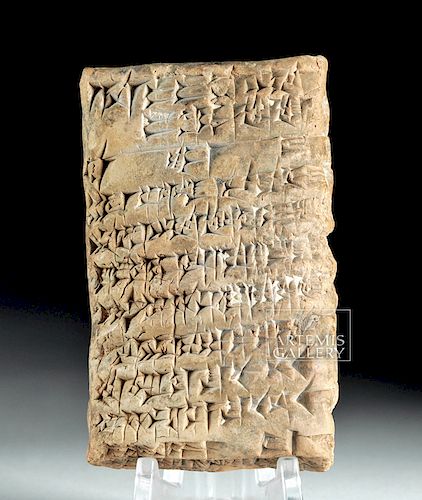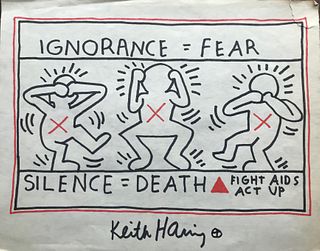Translated Babylonian Terracotta Cuneiform Tablet
Lot 89e
About Seller
Artemis Gallery
686 S Taylor Ave, Ste 106
Louisville, CO 80027
United States
Selling antiquities, ancient and ethnographic art online since 1993, Artemis Gallery specializes in Classical Antiquities (Egyptian, Greek, Roman, Near Eastern), Asian, Pre-Columbian, African / Tribal / Oceanographic art. Our extensive inventory includes pottery, stone, metal, wood, glass and textil...Read more
Categories
Estimate:
$2,500 - $3,500
Absentee vs Live bid
Two ways to bid:
- Leave a max absentee bid and the platform will bid on your behalf up to your maximum bid during the live auction.
- Bid live during the auction and your bids will be submitted real-time to the auctioneer.
Bid Increments
| Price | Bid Increment |
|---|---|
| $0 | $25 |
| $300 | $50 |
| $1,000 | $100 |
| $2,000 | $250 |
| $5,000 | $500 |
| $10,000 | $1,000 |
| $20,000 | $2,500 |
| $50,000 | $5,000 |
| $100,000 | $10,000 |
| $200,000 | $20,000 |
About Auction
By Artemis Gallery
May 10, 2018
Set Reminder
2018-05-10 10:00:00
2018-05-10 10:00:00
America/New_York
Bidsquare
Bidsquare : Fine Ethnographic / Asian / Ancient Art
https://www.bidsquare.com/auctions/artemis-gallery/fine-ethnographic-asian-ancient-art-3213
Featuring antiquities from around the world including Pre-Columbian, Tribal, Classical, Asian, so much more! Artemis Gallery info@artemisgallery.com
Featuring antiquities from around the world including Pre-Columbian, Tribal, Classical, Asian, so much more! Artemis Gallery info@artemisgallery.com
- Lot Description
Ancient Near East, northern Babylon, late Old Babylonian period, ca. 1700 to 1600 BCE. A hand-built terracotta cuneiform tablet, rectangular in form and rounded along the peripheries, concerning the misappropriation of servants to a military subordinate. The letter contains sixteen individual lines of Akkadian cuneiform script, formed by impressing a sharpened reed or wooden stick into the still-wet clay prior to the kiln-firing process. The top of the letter does not display any text, though text adorns the obverse, reverse, and bottom faces. Cuneiform was a generally pictographic style of writing in its infancy, though it became a more abstract style of letter-based script around the 3rd millennium BCE. Lucite display stand for photography purposes only. Size: 1.75" W x 2.875" H (4.4 cm x 7.3 cm).
While this tablet has been translated, some of the sign forms are unusual. This said, our general understanding is that the letter is written by a military subordinate addressing his captain/commander about the misappropriation of servants that were to be put under his command.
The translation is as follows, "Say to the captain whom Marduk preserves, 'Thus says Ninurta(!?)-mushallim: 'May Shamash and Marduk preserve you! May you live (long), may you be well! Concerning my servants "of" Sin-ma…(and?) Warad-Nabium, the commander, whom you took and you should interrogate those servants of mine, you will learn that they are my servants. You must not...(illegible). Today... (illegible). The payment in silver for them I will pay back. Bring them so I can take. Station them at the grain storage depot.'"
Provenance: private East Coast, USA collection
All items legal to buy/sell under U.S. Statute covering cultural patrimony Code 2600, CHAPTER 14, and are guaranteed to be as described or your money back.
A Certificate of Authenticity will accompany all winning bids.
We ship worldwide and handle all shipping in-house for your convenience.
#132503Surface wear and abrasions commensurate with age as expected, fading to some impressed lettering, light discoloration, small nicks to corners, and a couple of stable pressure fissures, otherwise intact and very good. Light earthen deposits within recessed areas.Condition
- Shipping Info
-
All shipping is handled in-house for your convenience. Your invoice from Artemis Gallery will include shipping calculation instructions. If in doubt, please inquire BEFORE bidding for estimated shipping costs for individual items.
-
- Buyer's Premium



 EUR
EUR CAD
CAD AUD
AUD GBP
GBP MXN
MXN HKD
HKD CNY
CNY MYR
MYR SEK
SEK SGD
SGD CHF
CHF THB
THB
















